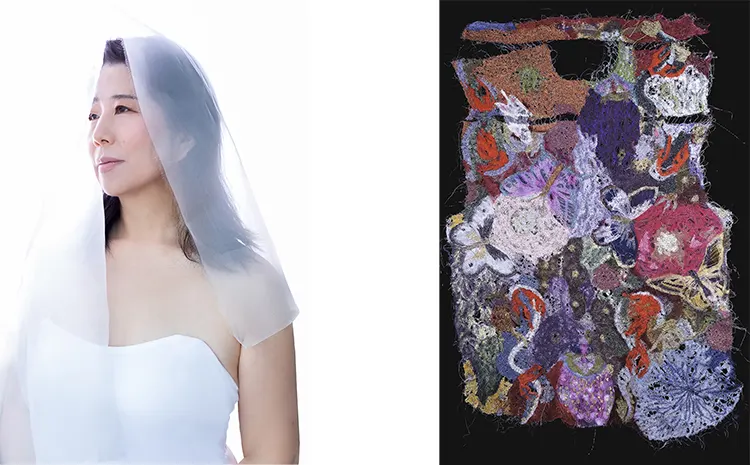“Buddha taught that this world is impermanent and insubstantial, and that our lives are suffering.”
Te Crucible of Craft: Aomi Kikuchi’s Formative Years
Aomi Kikuchi experienced profound loss early in life, with the passing of her mother when she was just nine years old. This poignant event introduced her to the teachings of Buddha on the impermanence, insubstantiality, and inherent suffering of existence. Captivated by the act of creation from her youth, Kikuchi delved into painting and later transitioned to a career in clothing design. Her artistic journey led her to immerse herself in an array of traditional craft techniques such as Yuzen dyeing, Japanese embroidery, ceramics, lacquer, weaving, and knitting.
In addition to honing her craft, Kikuchi complemented her technical acumen with a robust academic education, thereby forging a holistic path in the art realm. It was her tenure at Pratt’s graduate school that truly catalyzed her artistic ambition. Within its hallowed halls, Kikuchi encountered incisive critiques and drew profound inspiration from extensive lessons in art history and aesthetics. These experiences, coupled with the many years she dedicated to mastering craft techniques, provided the crucible for her distinctive artistic expression.

From Silk to Web: Kikuchi’s Evolution and Environmental Ethos
Upon completing her studies at Pratt Institute, Aomi Kikuchi embarked on a journey through various esteemed US residencies, including the renowned Textile Art Center. It was here that Kikuchi mastered the arts of weaving and machine knitting. Although Kikuchi possessed extensive expertise in dyeing techniques, she had not yet ventured into the realm of transitioning from thread to cloth. This intrinsic desire led her to the illustrious Nishijin region in Kyoto, celebrated for its world-class textiles. Thanks to the advancements of technology, even from the heart of Japan, Kikuchi remains abreast of global art developments, actively contributing to publications and marking her presence in online exhibitions.
Artistically, Kikuchi is a versatile talent. While her nascent endeavors were rooted in dyeing exquisite silk fabrics, a pivotal moment materialized when she discerned the unique potential of fraying silk organza edges, transmuting them into delicate spider web lace. Such revelations not only expanded her artistic vision but also heightened her awareness of the environmental implications linked to dyeing. These environmental reflections, synergized with the teachings of Buddha, play a profound role in shaping her masterpieces.

Mentorship, Masterpieces, and the Material World
In the tapestry of Aomi Kikuchi’s artistic influences, the luminary Itchiku Kubota prominently features. Kikuchi commenced her exploration of dyeing under the astute mentorship of Kubota, a master celebrated for his expertise in Yuzen dyeing and his pivotal role in resurrecting the 16th-century Tsujigahana dyeing technique. Experiencing Kubota’s craftsmanship up close profoundly shaped the trajectory of Kikuchi’s creative endeavors.
An emblematic piece in Kikuchi’s oeuvre is “Secret”. This composition, crafted by deconstructing and reassembling worn pieces from Victoria’s Secret using materials such as thread, goose down lace, and various remnants, speaks to her belief in the transformative nature of any material. Notably, this work earned a distinguished spot at the Art Laguna exhibition.
Kikuchi’s maiden voyage into the world of artistry was via the avenue of dressmaking, igniting her passion for textiles and the myriad techniques associated with them. Over the ensuing years, her repertoire has evolved, manifesting a deepened reverence for the environment. Kikuchi now deftly intertwines aesthetics with sustainability, selecting materials that epitomize both beauty and ecological responsibility.

“Pixel Weaving”: Aomi Kikuchi’s Next Artistic Frontier
Aomi Kikuchi is presently engrossed in an innovative endeavor she has named “pixel weaving.” This pioneering technique entails degrading the resolution of digital images and subsequently weaving them, possibly on an expansive scale. Kikuchi posits that pixel weaving holds the potential to revolutionize the manner in which photographs are presented.
In terms of her workspace, Kikuchi necessitates ample room for her diverse materials, encompassing techniques such as weaving and dyeing. Additionally, she employs specialized photographic equipment to meticulously document her artistic creations. While she ardently seeks to maintain an environment devoid of unnecessary distractions, Kikuchi remains cognizant of the need to intersperse periods of concentration with rejuvenating breaks and strolls for optimal well-being.





